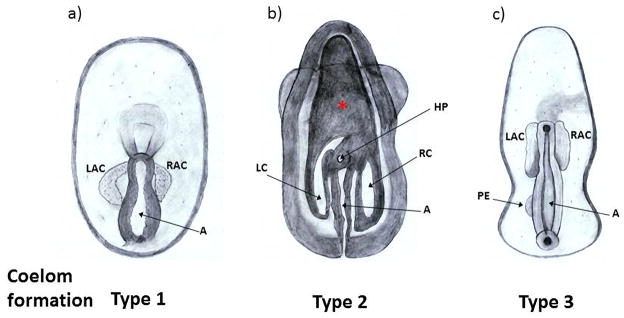Figure 5.

Different patterns for coelomic development in Asteroids. Schematic representation of the three different types of coelomic pouch formation. Dorsal view of larvae. a) 4-Day bipinaria larva from Pisaster ochraceus shows two lateral bulges derived from the anterior part of the archenteron which become the right and left enterocoels. b) In 4-Day brachiolaria larva of Parvulastra exigua, coeloms are conformed by three parts, an anterior coelom which extends from the archenteron, and two septa formed from the anterior coelom which become the left lateral coelom and the right lateral coelom. The anterior coelom and the archenteron are formed by a continuous cavity which can be seen in a ventral view of the larva. The left lateral coelom is larger than the right lateral coelom at the level of their junction with the archenteron. The hydropore is close to where the left lateral coelom joins the archenteron cavity. A red asterisk represents the localization of the anterior coelom in a ventral view of the larva (Morris et al., 2009). c) In 2.5-Day bipinaria larva from Patiriella regularis, right and left enteroels form from the expanded tip of the archenteron and a small group of cells forms the posterior enterocoel (Byrne and Barker, 1991). A: archenteron; LAC: left anterior enterocoel; RAC: right anterior enterocoel; LC: left lateral coelom; RC: right lateral coelom; HP: Hydropore; PE: Posterior enterocoel.
